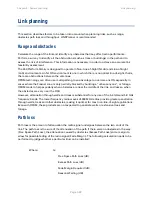
Chapter 3: System planning
Planning for connectorized units
Page 3-25
Planning for connectorized units
This section describes factors to be taken into account when planning to use connectorized ODUs
with external antennas in 450 Platform Family links.
When to install connectorized units
The majority of radio links can be successfully deployed with the integrated ODU. However the
integrated units may not be sufficient in some areas, for example:
Where the path is heavily obscured by dense woodland on an NLOS link.
Where long LOS links are required.
Where there are known to be high levels of interference.
In these areas, connectorized ODUs and external antennas should be used.
Choosing external antennas
When selecting external antennas, consider the following factors:
The required antenna gain.
Ease of mounting and alignment.
Use dual-polarization antenna (as the integrated antenna).
Note
Enter the antenna gain and cable loss into the Installation Wizard, if the country
selected has an EIRP limit, the corresponding maximum transmit power will be
calculated automatically by the unit.
Calculating RF cable length (5.8 GHz FCC only)
The 5.8 GHz band FCC approval for the product is based on tests with a cable loss between the
ODU and antenna of not less than 1.2 dB. If cable loss is below 1.2 dB with a 1.3 m (4 ft) diameter
external antenna, the connectorized 450 Platform Family may exceed the maximum radiated
spurious emissions allowed under FCC 5.8 GHz rules.
Cable loss depends mainly upon cable type and length. To meet or exceed the minimum loss of
1.2 dB, use cables of the type and length specified in
Table 66
(source: Times Microwave). This
data excludes connector losses.
Summary of Contents for PMP 450 Series
Page 125: ...Chapter 3 System planning Typical deployment Page 3 3 Figure 37 Wall installation...
Page 126: ...Chapter 3 System planning Typical deployment Page 3 4 Figure 38 Roof installation...
Page 127: ...Chapter 3 System planning Typical deployment Page 3 5 Figure 39 GPS receiver wall installation...
















































